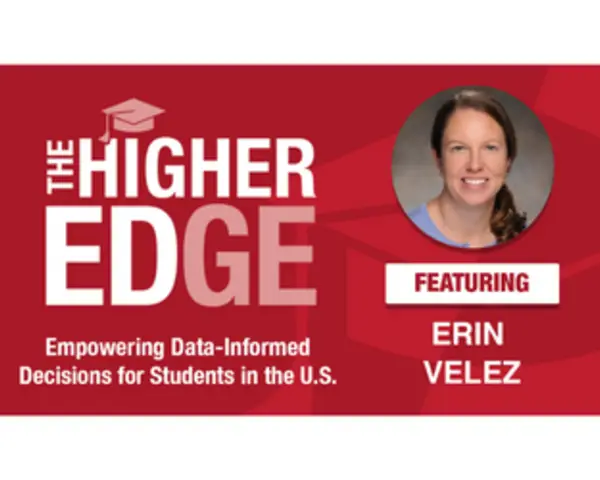Modernizing a Postsecondary Data Infrastructure
RTI and our partners from the Institute for Higher Education Policy (IHEP) worked to advise the modernization of postsecondary data infrastructures. We gathered insights from experts, state systems, higher education associations, and more to discuss issues that the National Center for Education Statistics (NCES) would need to consider to successfully create and implement a Student-Level Data Network (SLDN).
Building A Federal Student-Level Data Network (SLDN)
There is a steadily growing consensus around a critical issue in our nation’s higher education system: the need to modernize our postsecondary data infrastructure. Recognizing that building the Student-Level Data Network (SLDN) outlined in pending federal legislation will require the National Center for Education Statistics (NCES) to make key decisions around design, construction, and implementation, the Institute for Higher Education Policy (IHEP) partnered with RTI to gather insights to inform the creation of an SLDN.

Implementing a federal student-level data network: Advice from experts
“Implementing a Student-Level Data Network: Advice from Experts,” shares the insights from a conversation with 15 experts from institutions, state systems, think tanks, and higher education associations. This brief outlines the data elements and definitional options needed to meet pending legislative requirements, maximize the quality and utility of the data, and minimize the burden on institutions. The postsecondary data elements fit in five categories: enrollment and completion; financial aid; demographics; post-completion outcomes; and institutional characteristics. The brief also highlights areas of postsecondary data infrastructure that need further investigation and identifies the most pressing near-term topics in order to provide NCES and the legislatively-mandated Advisory Committee a foundation from which to start.

Implementing a federal student-level data network (part II): Insights from institutional representatives
The current federal postsecondary data landscape, although composed of high-quality data that helps stakeholders answer some questions related to students and their outcomes, has gaps that leave many questions unanswered. Only by deliberately engaging all stakeholders will NCES be able to thoughtfully design a postsecondary data system that simultaneously meets legislative requirement and augments institutions' understanding of how they serve their students. In September 2020, RTI and IHEP convened a second forum, which focused on data submission to an SLDN from the institution perspective, and this brief captures the key points of that discussion.

Implementing a federal student-level data network (part III): Insights from financial aid experts
Although the current federal postsecondary data landscape comprises high-quality data on a range of indicators, it has gaps that leave many important questions from policymakers, institutions, and students unanswered. During the previous two SLDN forums, panelists raised a number of issues related to potential financial aid variables in a student-level data network; these concerns led RTI and IHEP to engage financial aid professionals in May 2021 for the third forum. This brief captures the key points of that discussion for consideration by NCES. We do not draw conclusions or recommend solutions in this brief; our intention is to raise awareness about important issues that NCES and the SLDN designers will face if Congress mandates an SLDN.

Implementing a federal student-level data network (part IV): Exploring design options
The fourth and most recent SLDN forum was held in May 2022 and is the focus of this report, centering around three potential models for a federal SLDN, each separately devised by pairs of experts knowledgeable in student-level postsecondary data collection efforts. Participants attending the forum provided feedback and identified areas for further exploration related to each design, as captured in this report. We do not draw conclusions or recommend solutions in this brief; our intention is to raise awareness about important issues that NCES and the SLDN designers will face if Congress mandates an SLDN.

Learning from Statewide Longitudinal Data Systems (SLDS)
Building a Student-Level Data Network (SLDN) as outlined in pending federal legislation will be a complex and challenging undertaking. Fortunately, however, nearly all U.S. states have already built, or are building, state-level data systems which integrate education data from multiple sources. Learning from the experiences of these states can help inform how best to build a federal data system. This brief, SLDN Landscape and Recommendations, explores those lessons learned and articulates several high-level recommendations. The brief, and the accompanying blog post, describes and shares many of those lessons learned.

Empowering Data-Informed Decisions for Students in the U.S.
Erin Dunlop Velez joined The Higher Edge podcast to discuss how a student-level data network (SLDN) can modernize our postsecondary data infrastructure and help students make informed decisions about their higher education.

Student Level Data Networks Abroad: Considerations on SLDN Design from Six Countries
The U.S. federal government currently uses an institution-level data reporting system (IPEDS) to track student enrollment, costs, and outcomes, but many within the field of Higher Education believe that this aggregate picture is incomplete. While a federally managed Student-Level Data Network (SLDN) could offer deeper insights into educational pathways and nationwide trends, concerns over privacy, administrative burden, and technical challenges have blocked the creation of an SLDN to date. This report examines how six countries—Australia, Canada, Germany, Norway, Switzerland, and the U.K.—have successfully implemented student-level data systems, offering key considerations on the design, governance, and implementation of a national SLDN.

Imagining the Future of Postsecondary Education Data: The Role of a Federal Student-Level Data Network
This report examines how a proposed federal student-level data network (SLDN) could add efficiencies and reduce burdens in future federal sample survey research efforts. It first analyzes the extent to which data generated through four NCES sample studies could be approximated or replicated by the SLDN proposed in current legislation (College Transparency Act) and then considers how such an SLDN could serve as a sampling frame for future editions of these studies.

Implementing a Student-Level Data Network: Considerations from Data Reporters and Users
The College Transparency Act (CTA), which has been introduced in the 115th through 119th Congresses, directs the U.S. Department of Education to develop and implement a secure and privacy-protected postsecondary student-level data system. If the CTA passes and is signed into law, much of the burden of reporting these data will fall to Institutional Research Professionals (IRPs), who often struggle with competing reporting burdens. This report prioritizes the voices of IRPs to gain insights into how a federal student unit data system can be implemented effectively and to the benefit of institutions.
- Institute for Higher Education Policy (IHEP)






